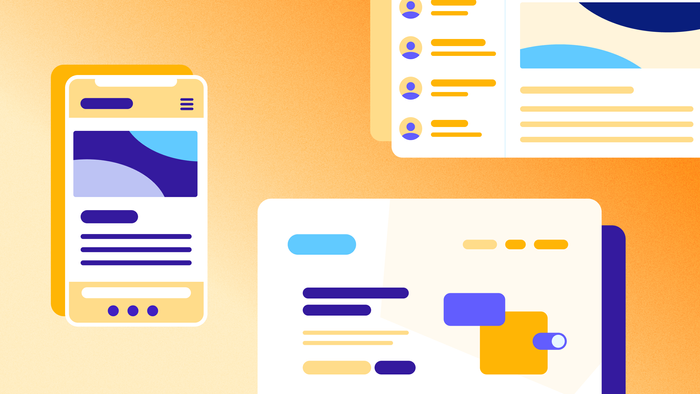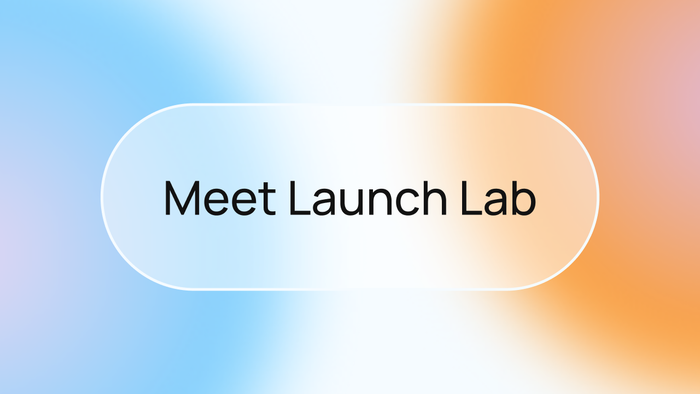When you’re building a startup, speed is of the essence.
If you’re looking to build and grow a digital product, you might be wondering, “Is there a way to build this myself faster, without having to hire someone to code it or maintain it once it’s built?”
With Bubble, the answer is absolutely.
Bubble is a software development platform that allows anyone to build, launch, and manage a fully functional app without writing code. Our drag-and-drop no-code editor gives you the flexibility and power to build just about anything without coding. Bubble’s no-code approach to visual programming means that anyone from first-time entrepreneurs to enterprise-level companies can take an idea from concept to fully functional, scalable reality.
Not sure if Bubble will work for your idea? It almost certainly will. But in this article, we’ll show you some of the most popular types of apps you can build on Bubble, featuring successful examples from our community of builders.
Got an idea already? Jump to Bubble no-code examples:
- AI-based no-code apps
- Custom marketplaces
- Jobs boards
- Community and review sites
- Social networks
- Personal finance tools
- EdTech tools
- Internal tools
- CRMs
- SaaS apps
What you can build with Bubble’s no-code editor
Many building platforms focus on just one or two aspects of the web development process, like designing landing pages or managing the data your app collects. Bubble’s full-stack visual programming platform does it all — and you don’t have to know code!
In our drag-and-drop editor, you can:
- Design the way your app looks (e.g., creating app screens or web pages)
- Create functionality for your app (e.g., allowing users to sign up or complete tasks)
- Organize and manage the data your app needs to work (e.g., user IDs, profile information, or posts and comments)
- and more!
Plus, you can integrate with other tools in your tech stack (like Slack or calendar apps) via plugins and APIs.
With Bubble, you can use no-code to build your idea across any of three main categories: websites, web apps, and native mobile apps.
Websites
You might hear any piece of digital, online software called a “website,” but a true website is a static landing page (or related set of landing pages) accessed via a browser. Bubble is great for building websites — in fact, we built Bubble’s website on Bubble!

Bubble’s visual editor lets you drag and drop visual elements to your page to create the design and program functional workflows in the background for things like buttons, search functionality, and more.
Minimum Studio is another great example of how to build a website on Bubble. They’ve created a highly interactive and visually stunning website that’s not only received overwhelming positive feedback from their clients and prospects, but also earned them “Best Homepage Design” at the BubbleCon2024 Community Awards.

The sleek design and advanced interactions and animations are made possible by Bubble’s no-code platform combined with custom plugins and innovative techniques. It’s a great example of how you can achieve clean, ambitious, effective design on Bubble. But websites only scratch the surface of what you can build on Bubble.
Web apps
A web app is an interactive piece of software — the programs and scripts that make your computer do things — that runs in your browser. Unlike a website, which is static, web apps have functionality and interactivity that allow visitors to use the software to accomplish goals or perform tasks.
Web apps range from the simple (like a basic to-do list manager) to the complex (like CRMs or social media platforms). Bubble is one of the fastest and easiest ways to build a web app with built-in databases, full customization and functionality, and everything you need for any level of complexity.
Bubble can even easily handle apps that run and use AI like ChatGPT, Claude, and more. In Bubble’s 2024 Community Awards, the “Most Innovative” and “Fastest Growing” app categories were both won by apps using AI.
Take Ringly, for example. Built on Bubble, Ringly offers AI-powered phone agents that can fully automate business calls. Or WriteHuman, one of the fastest-growing apps on Bubble, that offers an AI-driven solution to help businesses create content at scale. Even apps with very complex workflows, backends, databases, and logic can be built — and scaled — on Bubble.
Native mobile apps
Native mobile apps are software you download and access from your phone or another device. The apps are “native,” meaning they’re built and designed for a specific operating system (OS), and often use gestures, interactions, push notifications, and other device-specific functionality.
We recently launched the invite-only beta for native mobile app building functionality on Bubble, and our early testers have already created some really exciting products:
- ChurchSpace uses an Airbnb model to connect empty churches with anyone looking for space. Since partnering with Rapid Dev to build their native mobile app on Bubble, they’ve been able to work three times faster and save five times the cost compared to traditional code.
- Idea Link just published their native mobile app built on Bubble in the Apple App Store. You can download Sentio, an AI-driven app that helps you track and understand your emotions, offering personalized support and insights to improve your mental health.
- VisionUs is partnering with WeGetDesign to build pebblz, a mobile app that’s making volunteering more accessible through micro-challenges and instant recognition. In a space that’s been historically resource-strapped, VisionUs has been able to work seven times faster with Bubble.
When building mobile apps on Bubble, you can build with native interactions and features, all within Bubble’s drag-and-drop visual editor. And better yet: With one platform for building both native and web apps, you can build your idea and bring it to more audiences faster. Publish your apps to the Apple App Store and Google Play store directly from the Bubble editor. They’ll work for iOS and Android right out of the box — no wrapper needed.
No-code app examples
Bubble has powered three million builders to create 4.69 million apps across 217 countries. We’re proud of how we’ve pushed the limits of what people thought no-code was capable of — but we’re even more proud of our community of builders and founders who are using Bubble to create innovative, helpful solutions.
Here are some of the best no-code examples of the different kinds of apps you can build on Bubble.
Artificial intelligence solutions
Artificial intelligence (AI) is pretty ubiquitous these days, so why not harness its power for your Bubble app? Think AI is too complex for no-code? Think again! There are already thousands of Bubble-built apps using AI to power innovative solutions. Whether you’re thinking about personalized recommendations, sentiment analysis, chatbots and virtual assistants, or something else, Bubble lets you build apps with AI at the center, such as a ChatGPT-style AI chatbot, or simply incorporate it as a powerful feature of your app.
Synthflow

Synthflow helps teams build their own AI phone agents for specific purposes (such as scheduling appointments or generating leads) — all without having to write code. For no-code enthusiast and Synthflow founder Albert Astabatsyan, building Synthflow on Bubble took just two weeks. This speed offers them a competitive advantage in a rapidly changing AI market.
“We love to be in this ecosystem,” co-founder Hakob Astabatsyan said. “Bubble is becoming larger and larger. It’s probably the ultimate horizontal solution out there that allows people to build applications. I think that’s a great thing in general — building and supporting the ecosystem we really love.”
Formula Bot

Formula Bot won Bubble’s 2024 Community Award for “Best Use of AI.”
This AI app helps teams simplify complex data tasks through data integration and AI-powered formula generation for prepping, analyzing, visualizing, and enriching data. You can even upload your data to their chatbot and “chat” with your data — asking questions and letting AI read and analyze your data to provide you with the answer — no formulas needed.
Voicepen AI

Voicepen AI is another impressive example of an AI-powered app built on Bubble. It quickly transcribes videos and audio recordings and converts them into engaging written content. You can also feed it a website to get help generating content ideas for your business. Voicepen AI integrates with Whisper and ChatGPT to produce its recommendations. Fun fact: Co-founder and professional Bubble Developer Marina Trajkovska built the first version of the app in a single summer.
Custom marketplaces
These days, there are so many online marketplaces — and marketplace builders and providers, like Shopify — that will help you buy and sell just about anything. But if you’re looking to build something truly innovative, like a marketplace for NFTs or music lessons, existing out-of-the-box e-commerce solutions won’t work as well for you.
That’s where Bubble comes in. Bubble’s repeating groups and built-in user sign-in systems let you create multi-way marketplaces with ease. You can even build a subscription engine to integrate with Stripe for one-off or recurring payments.
Cuure
Cuure is a great example of a custom marketplace built on Bubble.

The personalized vitamins and supplement subscription company lets users find the just-right vitamins and supplements for their needs based on a personalized assessment. Due to the level of personalization, a pre-built shopping or e-commerce engine wouldn’t work. Instead, founder Jules Marcilhacy built Cuure’s initial marketplace in just one weekend on Bubble. Bubble’s customizable and flexible workflows are the perfect way to support Cuure’s personalized algorithm and shopping experiences.
Now, Cuure has grown to $10 million in funding, over €100,000 in revenue a month, and more than 30 employees — all while building, iterating, and scaling on Bubble.
Messly

Messly is a great example of a location-based marketplace — one that’s started to scale for global expansion.
Messly created a more efficient way to find work as a locum tenens (i.e., substitute or temporary) physician. Like Uber, Messly matches hospitals with available doctors in the UK. Building Messly on Bubble gives co-founder Dr. Abrar Gundroo a massive advantage: Abrar says that Bubble is “probably 12 to 20 times faster than what we did before” with traditional development processes.
Abrar also used Bubble to release a native mobile app using BDK (and with Bubble’s new native mobile functionality, even wrappers will soon be a thing of the past!).
Looking to create a similar, location-based marketplace? Learn the basics of building an e-commerce platform on Bubble, then dive into working with location data to build out specialized features.
Design Match

Design Match is another great example of using Bubble to create a customized marketplace based on personalized recommendations.
With Design Match, founders who are building products can get matched with pre-vetted designers that match their needs, budget, industry, and more based on a customized questionnaire. Building this on Bubble requires configuring your Bubble app to search for the right data and designing workflows that can power your questionnaire and the personalized recommendations.
If you’re just getting started, our complete guide to building a marketplace on Bubble has all the resources, templates, and tutorials you need to bring your no-code app to life quickly.
CircleHome

CircleHome co-founders David Liria and Xavier Lloveras built CircleHome as a way to swap homes with other travelers — and Bubble provided a simple, affordable way to build.
Strong search functionality and basic user accounts let early users browse listings and add their own. Bubble also helped them create:
- Custom booking portals to deliver quotes and manage payments
- Dynamic listings with backend support to manage requests
- Personalized recommendation engines and dynamic search
From there, it was off to a startup accelerator, a €120,000 pre-seed funding round, and now, an expanding user base in over 10 countries.
Jobs boards
Finding a new role can be hard, and LinkedIn isn’t always the best option. So, where do you turn? Industry-specific job boards can be a much-needed resource for job seekers today.
And on Bubble, you can build searchable and contribution-friendly databases of jobs for any industry, with specialized roles for talent, companies, or hiring managers. Best of all? You don’t need to hire anyone to make it happen.
Flexiple
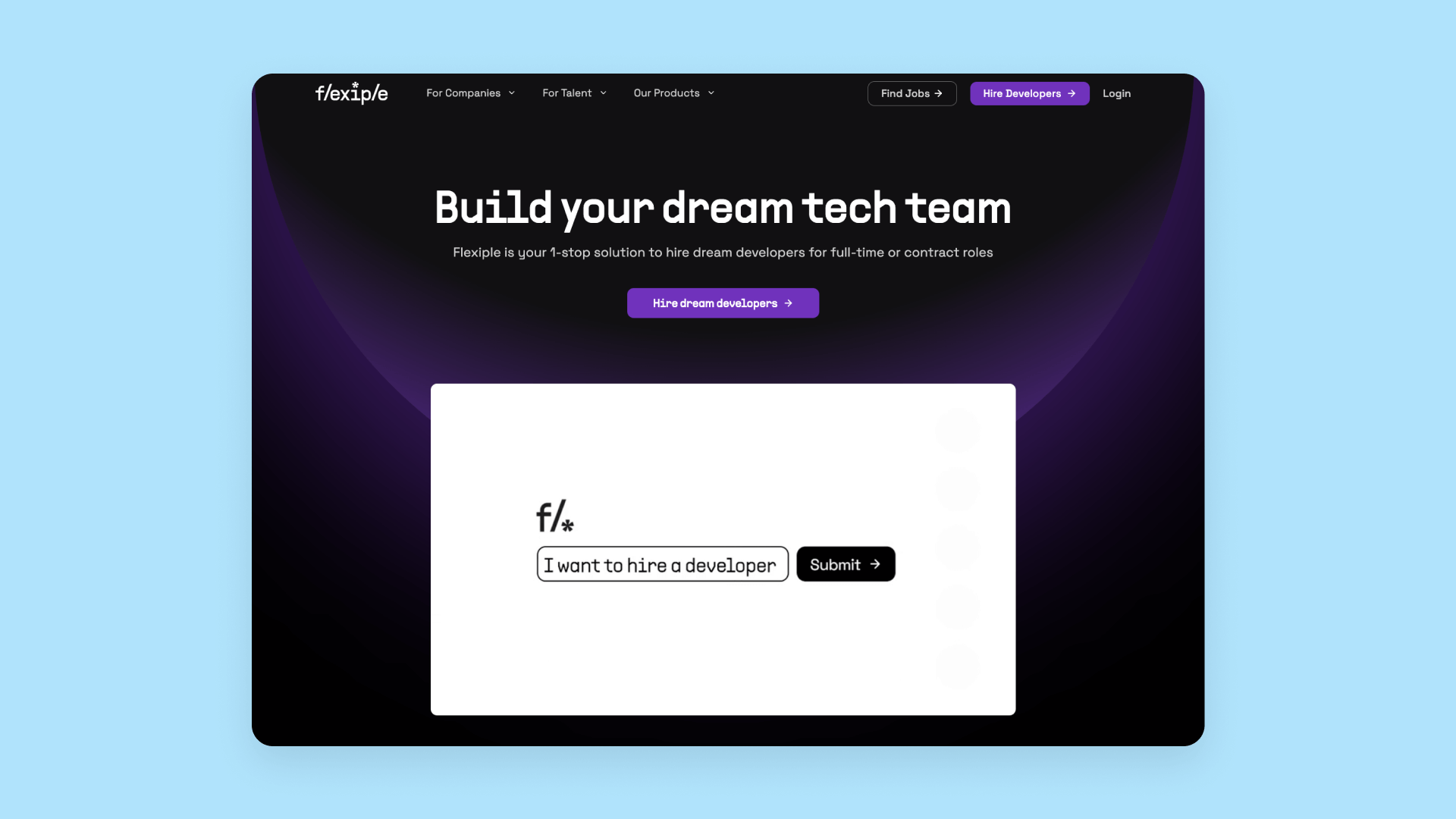
Flexiple is a great example of a standout job board — and it’s built on Bubble. Their goal is to connect top tech talent with companies who are hiring.
They started out with a rough MVP that worked by tying several tools together, but it had a lot of bugs. They quickly realized Bubble could be the affordable, simple solution to grow and scale their business. On Bubble, they’ve been able to design unique experiences for different types of Flexiple users, from job-seeking members to company recruiters.
“The level of empowerment Bubble gave me was great, and the speed with which we could build was so much quicker,” said co-founder Karthik Sridharan. Now, they’ve scaled to more than $3 million in annual revenue — with only one Bubble Developer on staff.
Brands Meet Creators

Brands Meet Creators created a non-traditional “job board” where brands and creators can connect directly about partnership opportunities and influencer marketing. Brands can post available opportunities and creators can reach out directly if they’re a good fit.
Or, brands can browse creators within certain filters or parameters to find UGC, organic partnerships, and so on. A rich database with strong filters and search functionality makes job boards like Brands Meet Creators effective — and Bubble’s endlessly customizable databases make that possible.
Community and review sites
Forums and online communities are some of the oldest kinds of web apps. Today, you can build sophisticated communities for your users, all without a single line of code. Commenting, reviews, and “upvote” systems are fairly easy to implement on Bubble, which isn’t always possible on other no-code solutions. You can also integrate your web app with other tools in your tech stack to track requests, customize moderation settings, and a whole lot more!
Deepwrk

Deepwrk combines elements of a community site with marketplace features, video conferencing tools, and more. On Deepwrk, users can take advantage of body doubling to meet (virtually) with another user and work on projects side-by-side for a set amount of time.
There’s also a dedicated community with rewards to gamify the experience and help users get more deep work done on a regular basis. How does all of this run on Bubble?
First up: calendar scheduling and booking. Then, video conferencing and workflows and actions to build in rewards for completed sessions. Plus, a supportive community via a forum to stay accountable and share wins.
Social networks
Today’s social media giants have come under a lot of scrutiny, and tons of new platforms are popping up to try to create healthier, more human-focused social networks. If you have an idea for how social media could be better, Bubble is a great way to bring it to life.
With no-code programming, you can build your network quickly and easily on your own — which means you can stay true to your values for the platform, no matter how much it grows.
Hampton
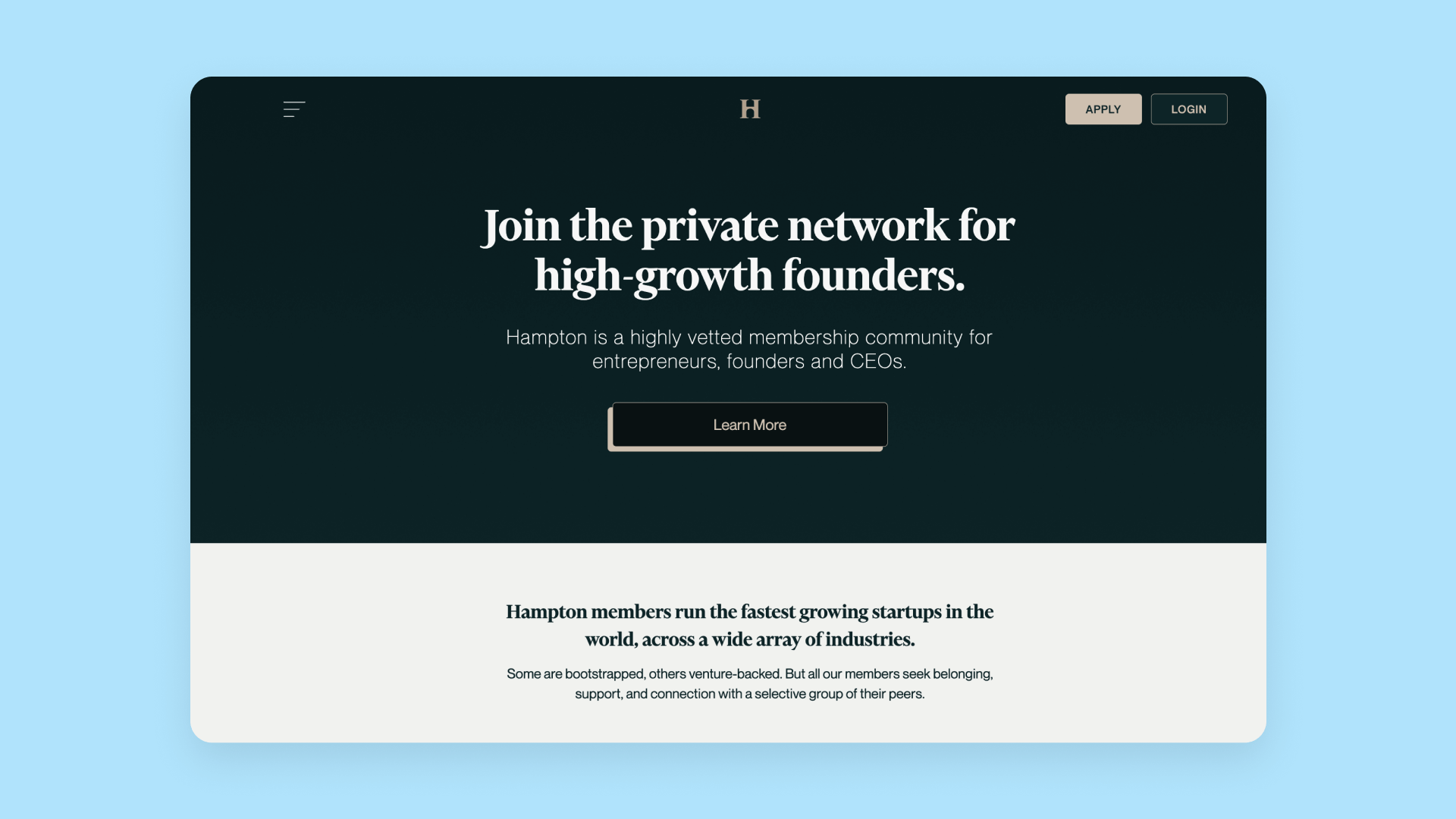
Hampton is a private, highly-vetted network for high-growth founders and CEOs. Co-founder Sam Parr (who built and sold the newsletter “The Hustle” to Hubspot a few years ago) built Hampton on Bubble to create the community he wanted to be a part of.
Bubble let Sam’s team build out all the features they needed for a truly valuable community — personal user profiles, a detailed search and filters for the directory, a vendor database for resources and perks, and more.
Reddit Clone

You’d be forgiven if you hopped onto this Reddit clone built on Bubble and thought it was the actual Reddit site!
This is a conceptual build created by one of our community members, Victor. He said he often gets questions about what you can build on Bubble and what Bubble’s capabilities are — building clones of popular websites helps him show founders and clients what Bubble can do. The cherry on top: This Reddit clone only took him about two weeks to build.
Nicheless
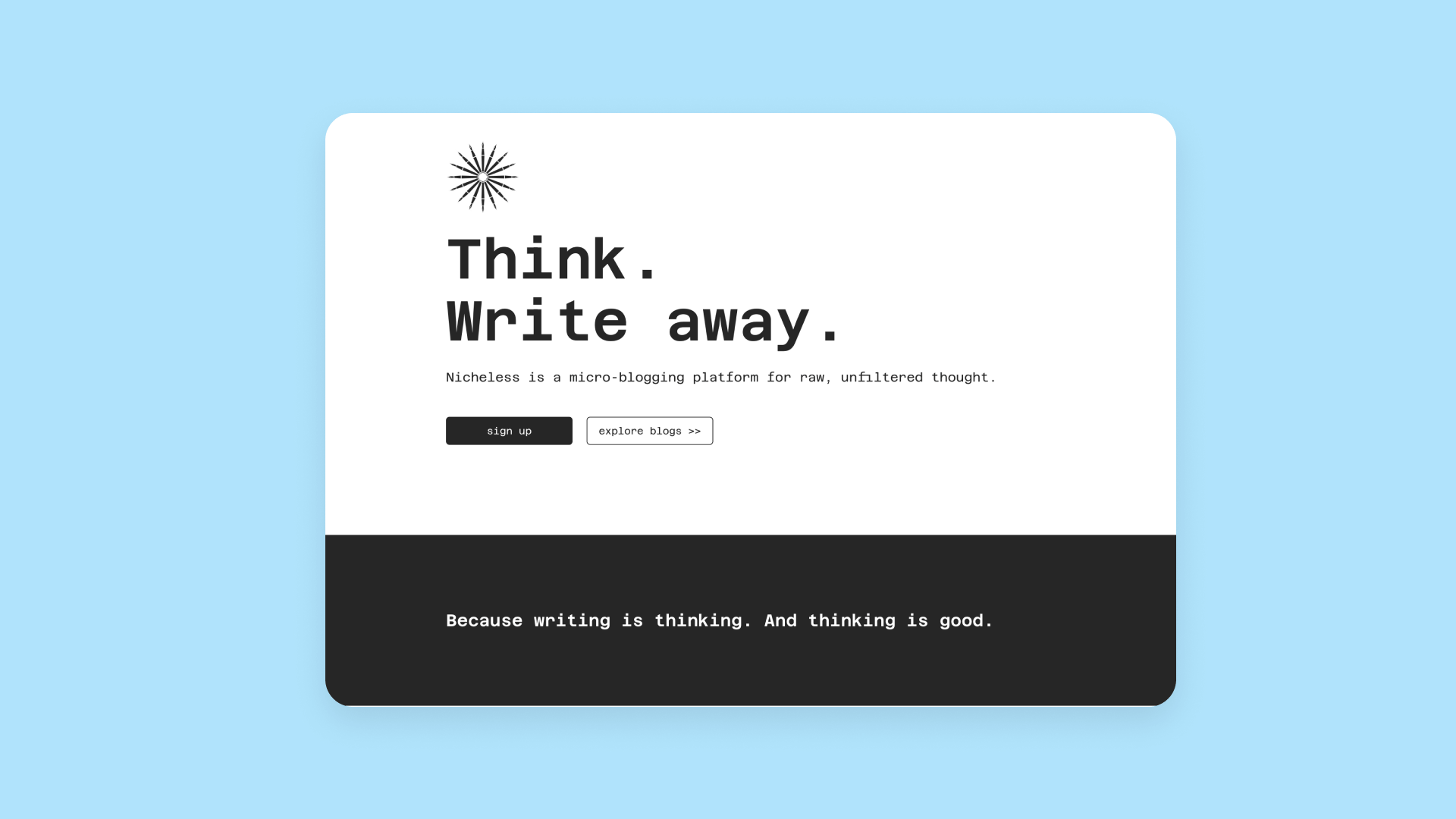
Nicheless is a micro-blogging site like Tumblr or Medium built on Bubble. Nicheless removes a lot of the status and growth-focused elements of writing online by hiding likes, comments, and subscribers, and instead focuses on providing a place where users can think “out loud,” be creative, and share and find thoughts on a wide variety of ideas.
Personal finance tools
Budgeting and invoice management tools are increasingly popular. Apps can offer simple ways to understand, manage, and save money more easily. Apps built on Bubble are no exception — whether it’s the ability to pay off debt, manage freelance earnings, track expenses, or something else, Bubble is a great (and secure!) platform for building personal finance tools.
Strabo
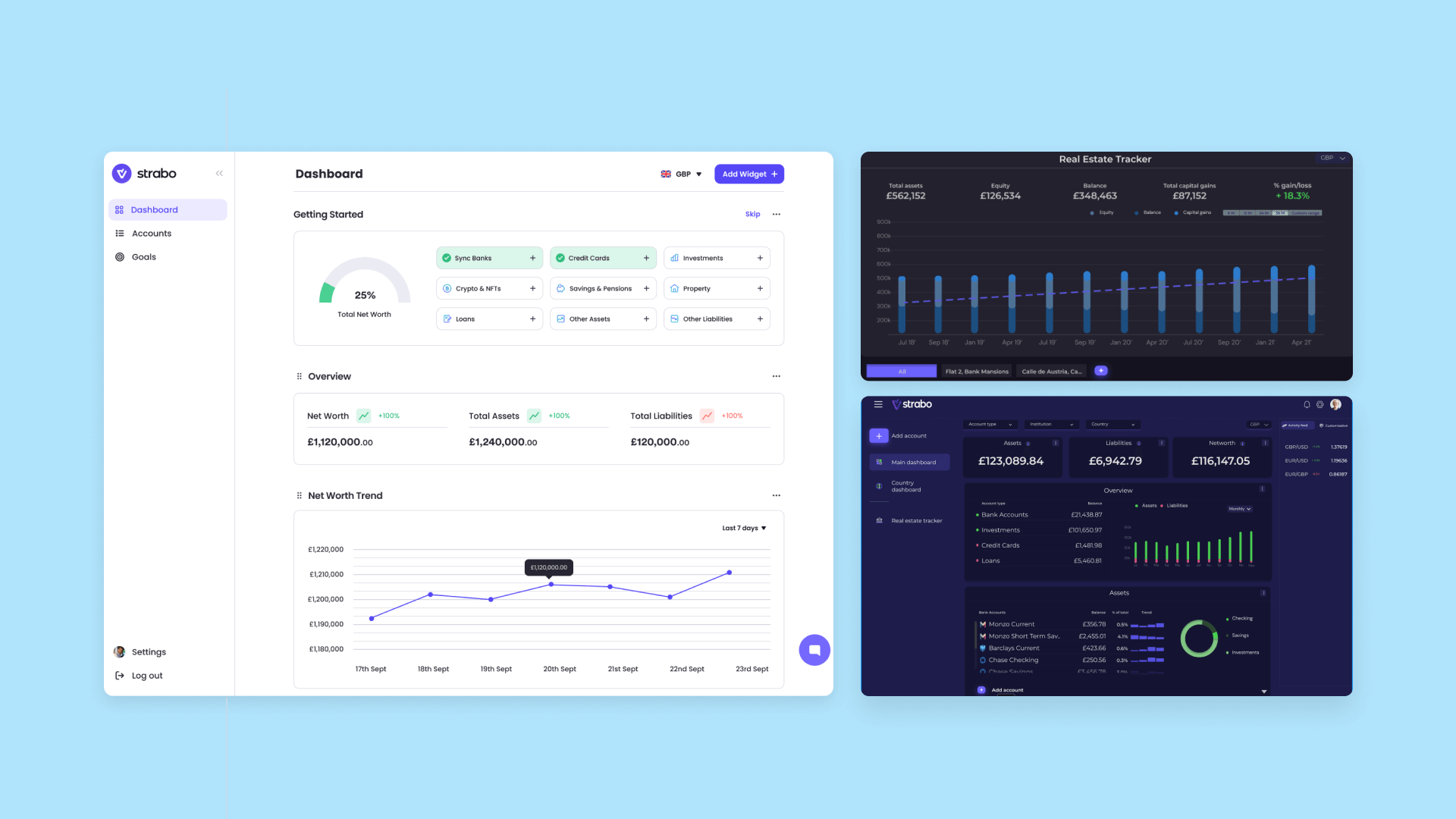
With Strabo, co-founders Michael Magdongon and Ben Waterman built the app they wanted to use themselves: a personal asset management tool built to handle international portfolios.
Bubble allowed them to build their app in less time, with fewer resources. But it also gave them the tools they needed to create powerful features.
For example, with Bubble’s API connector, they could easily integrate the app with various banking institutions’ open APIs, giving users an at-a-glance view of their entire portfolio. Bubble’s robust databases allow users to further sort their portfolio by currency, location segmentation, or investment vehicle.
Educational tools
Digital education tools — for in-classroom or remote learning — are more important than ever. EdTech innovations are building new ways to help students of all ages, parents, and teachers organize curriculum and assignments, deliver engaging content, and empower students to succeed.
And now, students from major universities are turning to Bubble to create apps for school projects, passion projects, or startups. Whether you’re using Bubble as an educational tool or for an educational tool, we’ve got you covered.
GoodCourse

GoodCourse is a great example of using Bubble to deliver high-quality, engaging, and modern education. With GoodCourse, business education and training is delivered in a modern, “Tik-tok style” to capture and engage Millennial and Gen Z workers.
“Bubble was the only platform that could end-to-end host our web application rather than trying to stitch together multiple tools at once,” co-founder Chris Mansfield said. Using Bubble’s API connector for Twilio, PostMark, and Sertifier integrations, the team built a tool to engage employees with micro-learning courses and content.
Even better: Bubble’s visual editor allows the rapid development needed for them to keep up with learning trends and iterate quickly based on user feedback.
Internal management tools and dashboards
One of the easiest ways to find the perfect project management tool or reporting dashboard for your team is to build your own — exactly what you need, exactly the way you want it. Bubble is an easy way to create the functionality you need.
MyBriefy

MyBriefy won Bubble’s 2024 Community Award for “Best Internal Tool.”
The tool was originally created for Global Titan Digital Marketing. The agency struggled with scattered client briefs, stored across email chains and Google Drives, which created disorganized projects, outdated information, and a poor client experience.
Now, with MyBriefy, not only is everything in one place, but the team can also use a simple, built-in CRM, brief templates, update notifications, and more to keep their workflows streamlined and organized.
Seagate
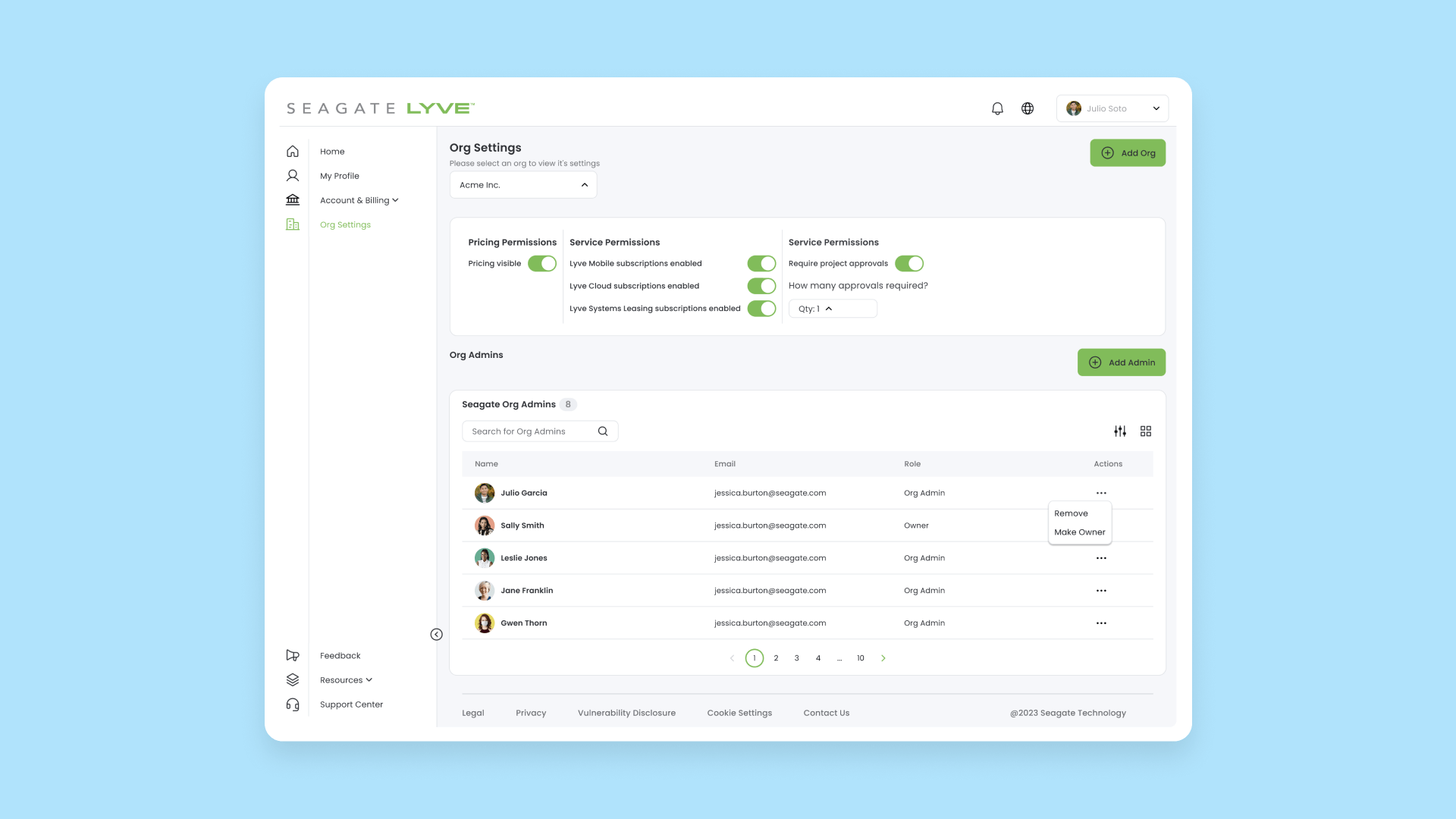
At Seagate, Product Manager and experienced Bubble Developer Michael Ong built a massive internal tool they call the “Admin Console.” It’s an internal hub that contains a suite of 11 different micro-apps, all built on Bubble.
Through the console, Seagate is able to manage everything from order fulfillment, other apps, and customer-facing work. Thankfully, Bubble offers the flexibility, security, and speed needed to keep all of their internal tools working smoothly.
They’ve even used Bubble to create a customer-facing management portal. Because Bubble is SOC 2 Type II compliant, the app was able to pass Seagate’s rigorous security standards easily. And now, Seagate customers can place device orders, invite others to that subscription, and grant remote access to that device via tokenized authentication — all in one, easy-to-access portal.
And it’s all powered by Bubble. Want to get started building your own dashboards and internal (or customer-facing) tools? Yep, we’ve got a guide for that, too. Get step-by-step details on all the features you’ll want to know, from building a user interface and setting up your databases to adding charts and more.
CRMs
A decade or more ago, building your own customer-relationship management tool (CRM) without code would have seemed impossible. But as no-code has evolved, it’s easier than ever for founders, product team leaders, and other non-technical makers to build their own custom software.
Whether you’re building an internal CRM to exactly suit the needs of your team or are hoping to build a CRM that can be used by thousands of other teams like yours, Bubble has the resources and platform ready to help you build and scale.
Revetize

Revetize is a CRM that allows businesses to run reviews, referrals, and loyalty campaigns. With Revetize, clients can pull in customer data and then automatically set up multi-channel drip campaigns, referral campaigns, and more. Even better: Clients can build all the landing pages, coupons, URLs, and other components necessary for these campaigns right in Revetize, creating a smooth, streamlined experience. Plus, real-time analytics and dashboards make it easy to see what’s working and what’s not.
Co-founder Richard Bitton came up with the idea when searching for something similar for his own company — but within three months, they were launching and monetizing the app for a wider audience.
Bubble’s expandable and customizable databases and data types make it possible to build a CRM of any type, for any industry or use case. Get started on your own with our complete CRM guide, or get a step-by-step walk-through on building a CRM like Salesforce on Bubble.
SaaS apps
SaaS — Software-as-a-Service — is an exploding software category today, home to the likes of Slack, Asana, Salesforce, Hubspot, and more. Want to build your own SaaS tool? Bubble is a great platform to do it.
Bubble’s endlessly flexible platform means you can add anything you need to your tool — from scheduling to project management, AI and chatbots, forums, messaging, charts and dashboards, and more. Even better: Rapid development and iteration means a stronger product-market fit from day one and beyond.
Aicado

Aicado was nominated for a Bubble Community Award in 2024 for “Best Use of AI” for their no-code AI implementation hub. In plain English, they help you customize AI models and integrate them into your website to suit your needs.
It’s still a smaller SaaS platform, but their site exceeds expectations for a SaaS website and their product checks all the boxes for their users — which just goes to show you don’t have to be a major enterprise tool to have a successful SaaS brand. And with Bubble, they have everything they need to keep iterating and scaling as they grow.
My AskAI

My AskAI won Bubble’s 2024 Community Award for “Best B2B Tool.” Their innovative and extensive use of Bubble’s software and programming language created a tool that’s truly transforming customer support for its users.
With My AskAI, teams can seamlessly integrate with other tools in their tech stack like Slack, Teams, and Zendesk, while also using AI support to simplify customer support and scale customer interactions — without sacrificing quality.
Bubble’s workflows, AI integrations, and other plugins help make a coordinated, cohesive SaaS tool possible. And when we asked co-founder Alex Rainey for advice he would share with others considering no-code, Alex didn’t mince words:
“Don’t listen to any of the negativity… the speed with which you can build on no-code and Bubble will completely set you apart from your competition and keep your costs super low,” he stresses. “I struggle to think of what you couldn’t build with a no-code builder like Bubble.”
Build anything with Bubble’s no-code programming
In short: If you can dream it, you can build it on Bubble.
Bubble’s powerful no-code platform gives makers the tools to build visually, without losing any functionality or customization of other programming languages. Web apps, mobile apps, simple forms, complex marketplaces, CRMs, or SaaS tools — the sky’s the limit.
With Bubble, you get the benefits of customization and flexibility alongside faster development and a human-first approach to programming that makes it much more accessible.
Then start building — for free! — on Bubble and bring your idea to life faster and easier→
Build for as long as you want on the Free plan. Only upgrade when you're ready to launch.
Join Bubble
